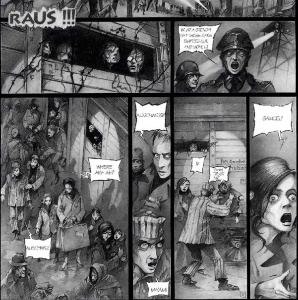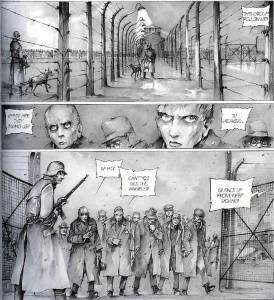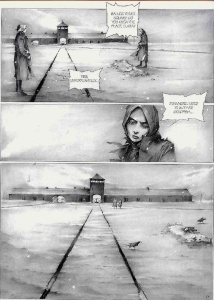Auschwitz: A Graphic Novel by Pascal Croci
Pascal Croci’s graphic novel, Auschwitz, begins with a question to a witness from Auschwitz-Birkenau; “How long have you been keeping all this to yourself?” The answer, “Fifty-two years,” is shocking. The novel that follows provides a glimpse into the reason why these experiences are almost impossible to speak about. And in doing so Croci uncovers more than a terrible history, he points to an intolerable present.
The first page traces the origins of anti-Semitism in early Christianity, then the medieval ghettoization of the Jews and finally the Nazi Final Solution. In the next panel irrational hatred finds a modern expression in the brutal ethnic war in 1993 Bosnia. An old couple, Kazik and Cessia, have sought refuge in a bombed out building and reflect on their distant past. He scratches the word zahor, remember, into a wall and demands that they now must both face their terrible memories of the war years. Immediately we are thrust into the nighttime arrival of the cattle cars at Auschwitz.

The fear, confusion, and terror of the first selection at the rail siding between men, women and children is vividly depicted. In graphic panel after panel the new inmates slowly realize the true nature of this concentration camp. The dialogue reflects the constant brutality and violence that greet them. “Where are they taking us? To heaven… What? Can’t you see the angels?…It isn’t snow… it’s ash. They’re burning your wives and children! In this place, you come in through the door, and you leave through the chimney…”
Violence is not exclusively from the Germans. Kapos beat and bully their charges and finally a Kapo is seen murdered by his fellow Jews. Violence breeds violence.
Kazik sees a sectioned off area that is for the “family camp,” mainly Czech Jews from Theresienstadt. He nurtures a hope that somehow his child, Ann, was mixed in with them. When he realizes that this special group is being taken to be gassed, he desperately joins the sonderkommandos, the Jews who worked in the gas chambers and the crematorium, as his only chance of seeing her again.

As the narrative moves forward into the horrors of the gas chambers and the almost incomprehensible images of burning bodies I begin to lose concentration. I have seen this before, if not in a graphic novel, then in testimony, films, documentaries and seemingly countless other forms. Why do we need to revisit this hell yet again. Towards the end it is revealed that Kazik’s wife and daughter do survive. In a final illustrated page in the abandoned camp we learn that their child dies of typhus two days before the camp was liberated. Crows have begun to pick at her tattered doll left on her makeshift grave. And then I turn the page.
Suddenly it is forty-eight years later, in the bombed out building in Bosnia, formerly Yugoslavia. Kazik and Cessia have survived Auschwitz only to be seized by roaming paramilitary units intent upon ethnic cleansing in 1993. They are accused of being traitors and are summarily shot. This ending changes everything.
Now I read the graphic novel a second time with new eyes and perspective. The introduction becomes an essential part of what follows because the actual ending takes place not in the distant past, but rather in a very recent present. I allow the design of the pages to sink in, the images alternating between different shaped panels, the dialogue balloons forms a rhythm across the page. The graphic artistry adds another dimension to the characters that I encounter a second time, now with increasing familiarity. Since the work is only seventy-two illustrated pages long, it is easy to read through many times until their experiences in Auschwitz forcefully impacts upon the contemporary reality of the 1990’s. The hate and violence of Auschwitz has become a horror of the present also.

After the final page there are ten pages of a highly unusual section of “Background Information.” The artist/author worked on this for five years, interviewed at least thirteen survivors, conducted extensive research and relied on further testimony contained in Claude Lanzmann’s documentary Shoah. Even thought the story itself is fictional, every detail and event originated from documented witnesses of Auschwitz.
In an extraordinary interview in the last section Croci confronts many questions concerning the creation of this graphic novel and the issues it raises. Perhaps the most powerful, and disturbing conclusion of this work is that “To avoid another Auschwitz, we have to face up to the contradictions at the heart of human nature” and perhaps must allow ourselves to “hate each other in peace” because “brotherly love [is] impossible!” This chilling message is what brings Croci’s Auschwitz into our contemporary reality.
Pascal Croci, a non-Jewish illustrator and author living in France, provides a totally different view of the Holocaust. His understanding is completely dependent on witnesses and fictional works, such as the movie Schindler’s List. It is perhaps exactly this distance from the Shoah that allows him to simultaneously empathize with and contemporize events that in some elemental sense belong to the Jewish people, not him.
In this bitter view of Auschwitz, the past for the Jews, for Europe and indeed for the rest of the world, will not go away. It revisits us with sickening regularity in ethnic cleansings, racial hatred, anti-Semitism and religious intolerance. The answer Croci’s Auschwitz suggests is a peculiar kind of hate, hatred in peace. he is calling for are recognized divisions between religious groups, borders, even walls, if necessary, to keep different peoples from killing each other. After over fifty years of failed attempts at understanding, the road to peace may be this view from Auschwitz.
Auschwitz
Graphic Novel by Pascal Croci
Harry N. Abrams, 2004
www.abramsbooks.com